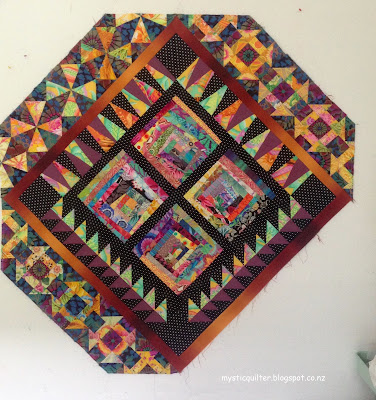It’s been a
while since our last metacognitive discussion. I finished another bipolar art quilt since then, but I'm going back to the first one for this essay.
 |
| Bipolar 3: Balance |
Are you ready to talk again? First
let’s review some of the discussion from last time.We talked about color,
their representations and the feelings they invoke. We also talked about shapes
and blocks and how we use them. Then we jumped into
those parts of the quilt that are unplanned. They just sort of happen. If you made
a quick jot list of your processes, take a look at that list. We’ll come back to
it in a bit.
Let’s have one more
conversation with that quilt from last time. Think about how that quilt
started. Did you pull fabrics? Did you begin with a block that you wanted to
use? Sometimes it’s a beautiful fabric that begins the work. What specific idea
started this quilt?
You’ve jot listed your
process already, now it’s time to determine whether that list is accurate. If
necessary, make changes and think about what you usually do. Did you do
anything differently on this quilt? If so, which method do you prefer? Which
works better for you? Can you pinpoint why? Make notes of any responses you
have to these questions and any other ideas that strike you as you think about
your processes.
 |
| Bipolar 1: Creative |
Take a moment to think about your other notes from the previous
discussion. This time dig deeper. Think about your thinking. Ask yourself why and
how. Why did you feel these emotions? How did you handle the negative ones? What
do you do when you feel encouraged or happy?
Think about your space and its atmosphere. How does it affect
you and your work?
- ·
Sound: Do you work in
quiet? Do you have music playing? What kind—upbeat, soft, soothing, etc. Do you
sing along? Do you focus better with or without sound?
- ·
Sight: What does your
workspace look like? Clean, organized, creatively messy, etc. What colors
surround you? What impedes your work or focus?
- ·
Smell: Do you have
candles or other scents? Which are your favorites? Do you always include scents
when you work?
- ·
Tactile/Logistical:
Which are your favorite fabrics? Do you “pet” your fabric? How often do you
clean your workspace? Does dust, clutter, etc. affect your mood? Is it
difficult to move around physically? Do you have enough space to put your work
down? Can you walk out and close the door or must you clean up after every
session?
- ·
Taste: What foods and
drinks do you generally have nearby? Coffee, tea, soda, etc. Snacks, healthy
snacks, etc. How often do you stop to refuel? How convenient is refueling?
- ·
Mood: Think about your
moods when you are in your studio space. Why do you feel this way? What
actionable things can you do in your space to improve your mood? How will you
put those to work?
- ·
Visitors: Do you allow
visitors in your space? Why or why not? How do you defend/share your space?
· Think about any other effects
that are in your space. Can you increase the positive ones? Can you decrease the
negative one? Make a list that you can return to at a later time when you are
ready to begin this work.
As I’ve done before, I will answer questions so that you can “see”
me “think out” my answers. To make this post a little more concise, however, I
will remove the parts of the paragraphs that are not applicable.
how that quilt
started. What specific idea started this quilt?
I started this quilt with an idea of wanting to extract or render
my thoughts about bipolar depression as a way of dealing with the feelings
associated with my having the disorder. The idea came from my pondering how I
was handling this complex frame of mind. It has now morphed into management skills for manic episodes.
Why did you feel these emotions? How did you handle the negative
ones? What do you do when you feel encouraged or happy?
I didn’t write what
my emotions were as I worked on the quilt. I remember feeling happy with the
quilt as it moved forward. I had worked out several techniques and had a plan before
pulling the fabrics. I was not concerned so much with the fabrics because I
knew I already had them in my stash. The techniques are relatively easy ones.
My plan did not include all the techniques I used, but I tend to play and work in
an improv kind of way, meaning I tend to give myself leeway to choose as I go
along.
I’ve always been an expressive
person with many moods. Opposing moods can occur at the same time—I am
bipolar. On those manic-all-over-the-place occasions I must fight the urge to abandon everything and try to find something small to focus on.
When I
am pleased with my work, I tend to sing, dance, move more. It’s as if
my mind and body work in tandem and are more fluid. Of course, the opposite
occurs when I get stuck. In those negative times I walk away from the project that frustrates me. I try to work on a philanthropy project. If I can convince myself to do something for just a
few minutes, I generally overcome the blah of a depressive mood. Of course, it
helps to take my medicine.
I’m not going to answer the laundry list of questions about my
studio. That would bore you half to death. Instead, I’ll let you get to your
own answers.

































